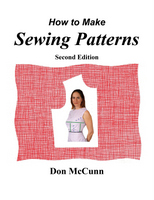|
Online Patternmaking Classes
by Don McCunn Online Class Home Page ► An Introduction
The Sleeve Sloper and Variations
The two sessions of this class include the following. The best way to start any patternmaking process is to understand the concept of why the patterns need to be shaped the way they do. For the Sleeve, I describe the basic concept in How to Make Sewing Patterns on page 79, 2nd ed. (page 71, 1st ed.) and in the video below. An Introduction This class is a continuation of the Upper Torso (aka Bodice) Sloper class. To follow the instructions for this class you should already have an Upper Torso Sloper that fits well. The sleeve pattern is based on the Side Seam of the Upper Torso patterns being located half way around the armscye curve from where the shoulder seam intersects with the armscye seam. The first week includes videos showing how to create a sleeve sloper that will work with the Upper Torso (aka Bodice) Sloper. The same instructions can be used for either women or men. In the second week you will see how to use this sloper to create different sleeve variations.
Online Class Home Page ► An Introduction ► Go To Week One
Copyright © 2007, & 2020 by Donald H. McCunn
| ||||||||||||||||||||||||||||||||||||||||
